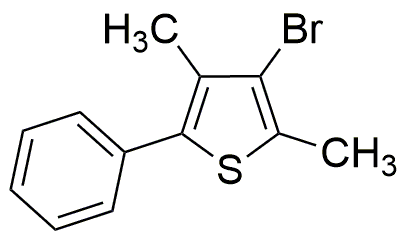3-Bromo-2,4-dimethyl-5-phenylthiophene is widely utilized in research focused on:
- Organic Electronics: This compound serves as a key building block in the synthesis of organic semiconductors, which are essential for developing flexible and lightweight electronic devices.
- Pharmaceutical Development: It is used in the design of novel pharmaceutical agents, particularly those targeting specific biological pathways, enhancing drug efficacy and specificity.
- Material Science: The compound plays a role in creating advanced materials with unique properties, such as improved conductivity and stability, beneficial for various industrial applications.
- Photovoltaics: It contributes to the development of organic solar cells, offering a more sustainable and cost-effective alternative to traditional silicon-based solar technology.
- Research in Organic Synthesis: This chemical is valuable in academic and industrial research for developing new synthetic methodologies, allowing chemists to explore innovative reactions and compounds.
Informations générales
Propriétés
Sécurité et réglementation
Applications
3-Bromo-2,4-dimethyl-5-phenylthiophene is widely utilized in research focused on:
- Organic Electronics: This compound serves as a key building block in the synthesis of organic semiconductors, which are essential for developing flexible and lightweight electronic devices.
- Pharmaceutical Development: It is used in the design of novel pharmaceutical agents, particularly those targeting specific biological pathways, enhancing drug efficacy and specificity.
- Material Science: The compound plays a role in creating advanced materials with unique properties, such as improved conductivity and stability, beneficial for various industrial applications.
- Photovoltaics: It contributes to the development of organic solar cells, offering a more sustainable and cost-effective alternative to traditional silicon-based solar technology.
- Research in Organic Synthesis: This chemical is valuable in academic and industrial research for developing new synthetic methodologies, allowing chemists to explore innovative reactions and compounds.
Documents
Fiches de données de sécurité (FDS)
La FDS fournit des informations de sécurité complètes sur la manipulation, le stockage et l’élimination du produit.
Spécifications du produit (PS)
Le PS fournit une description complète des propriétés du produit, notamment sa composition chimique, son état physique, sa pureté et les exigences de stockage. Il détaille également les plages de qualité acceptables et les applications prévues du produit.
Certificats d'analyse (COA)
Recherchez des certificats d'analyse (COA) en saisissant le numéro de lot du produit. Les numéros de lot et de lot se trouvent sur l'étiquette d'un produit, après les mots « Lot » ou « Lot de fabrication ».
Numéro de catalogue
Numéro de lot/série
Certificats d'origine (COO)
Ce certificat d'exploitation confirme le pays dans lequel le produit a été fabriqué, et détaille également les matériaux et composants utilisés et s'il est issu de sources naturelles, synthétiques ou autres sources spécifiques. Ce certificat peut être requis pour les douanes, le commerce et la conformité réglementaire.
Numéro de catalogue
Numéro de lot/série
Fiches de données de sécurité (FDS)
La FDS fournit des informations de sécurité complètes sur la manipulation, le stockage et l’élimination du produit.
DownloadSpécifications du produit (PS)
Le PS fournit une description complète des propriétés du produit, notamment sa composition chimique, son état physique, sa pureté et les exigences de stockage. Il détaille également les plages de qualité acceptables et les applications prévues du produit.
DownloadCertificats d'analyse (COA)
Recherchez des certificats d'analyse (COA) en saisissant le numéro de lot du produit. Les numéros de lot et de lot se trouvent sur l'étiquette d'un produit, après les mots « Lot » ou « Lot de fabrication ».
Numéro de catalogue
Numéro de lot/série
Certificats d'origine (COO)
Ce certificat d'exploitation confirme le pays dans lequel le produit a été fabriqué, et détaille également les matériaux et composants utilisés et s'il est issu de sources naturelles, synthétiques ou autres sources spécifiques. Ce certificat peut être requis pour les douanes, le commerce et la conformité réglementaire.


